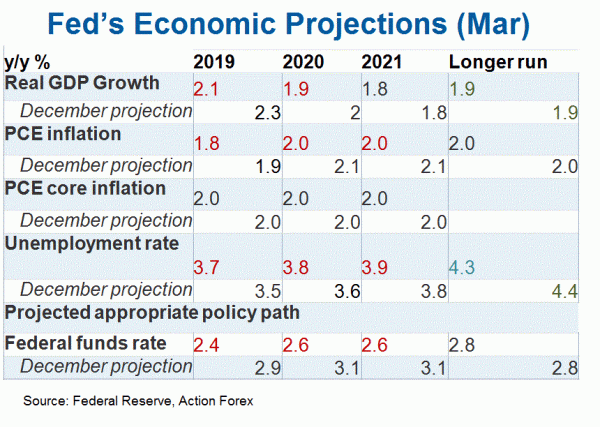The Fed has turned more dovish than previously expected. Besides downgrading the economic assessments at the policy statement, the members now expect no change in interest rate this year, followed by one rate hike in 2020. They also revised lower the economic projections and decided to terminate the balance sheet reduction plan in September this year.
Economic Projections
As noted in the accompanying statement, the inter-meeting economic data showed that “the labor market remains strong but that growth of economic activity has slowed from its solid rate in the fourth quarter. Payroll employment was little changed in February, but job gains have been solid, on average, in recent months, and the unemployment rate has remained low”. In January, the members judged that the “labor market has continued to strengthen and that economic activity has been rising at a solid rate”. They added that “job gains have been strong, on average, in recent months, and the unemployment rate has remained low”. On consumption and investment, the members acknowledged that “slower growth of household spending and business fixed investment in the first quarter”. This was compared with the optimism displayed in January: “Household spending has continued to grow strongly, while growth of business fixed investment has moderated from its rapid pace earlier last year”. On inflation, the members this month acknowledged the moderation in headline inflation due to “lower energy prices”. The downgrades in economic assessment were reflected in the updated projections:
Median Dot Plots
The quarterly median dot plots show that the majority of members (11 out of 17) expect the median policy rate to stay at 2.375% (i.e. no rate hike) this year, compared with 2.875% in December. For 2020, the members forecast the median policy rate to rise to 2.625% (one rate hike). Although the members retained the view of having one rate hike in 2020, their projected level of interest rate is actually lower than December’s estimate of 3.125%.
Balance Sheet Reduction
There is an abrupt change in Fed’s balance sheet reduction plan. From May to September, the Fed would cut the size of Treasury securities reduction by half, to US$15B/ month, while the size of mortgage-backed securities (MBS) reduction stays unchanged at US$ 20B/ month. From October onward, the Fed would stop reducing its Treasury position. Rather it would take up to US$20B/ month in maturing mortgage securities and roll them into Treasury debts.


 Signal2forex.com - Best Forex robots and signals
Signal2forex.com - Best Forex robots and signals




